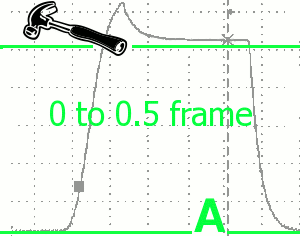ViewSonic VP930 LCD Monitor: The New Champion?
Overshoot
The 191b used an Overdrive with a duration of less than one video frame. The 930 does even better than that - the overshoot was invisible on the oscilloscope. That's excellent performance.

In Practice
Quite obviously, office applications are a joy to use on this monitor. With all the adjustments for tilt, height, and rotation, and the presence of a pivot mode, you can work on documents under optimal conditions. You will need to lower the brightness a little to avoid eye fatigue, though. With its great color fidelity, the monitor will also make digital photography buffs very happy.
The 930 was perfectly at ease with video games, but it's not the fastest monitor available. Other, less accurate ones offer even lower latency. And we were able to detect a slight reddish track behind the mouse cursor when moving it laterally from left to right on a blue background. Also, a few "shear" effects like those we'd observed with the VX924 were also discernable here, but fortunately that effect has been greatly reduced on the 930.
Video Games
We rate the suitability of an LCD monitor for gaming using a five-point system. To do it, we test the panels with different types of games - first person shooters, real-time strategy games, role-playing games, etc. The panel's reactivity is obviously the first thing we look at, but color quality is also important where certain titles are concerned.
For screening movies, the VP930 did fairly well, but any difference between it and the VP191b was far from obvious. We did notice fairly little video noise - less than what you see on a TN panel, no doubt about that. The viewing angles were perfect; LCD manufacturers have made impressive progress in this area.
Movies
Stay on the Cutting Edge
Join the experts who read Tom's Hardware for the inside track on enthusiast PC tech news — and have for over 25 years. We'll send breaking news and in-depth reviews of CPUs, GPUs, AI, maker hardware and more straight to your inbox.
Here again we rate on a five-point scale. Latency is one criterion, and we also evaluate the amount of noise the monitor injects into movies. Good viewing angles are also crucial for multimedia applications.
Most Popular

